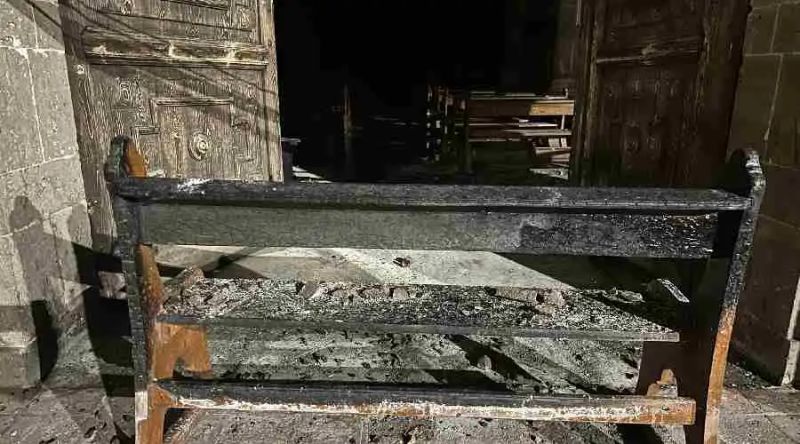
ACI Prensa Staff, May 16, 2023 / 16:30 pm (CNA).
The Diocese of Irapuato in the Mexican state of Guanajuato expressed its “profound consternation” over a fire deliberately set at Santiaguito (St. James) Church and called it a “sacrilege.”
In a statement published May 15, Father Efrén Silva Plascencia, spokesman for the diocese, said that the fire “was set on the exterior by a male person who arrived outside the church at 1:04 a.m. and left at 1:26 a.m.”
Silva pointed out that the Church of Santiaguito, whose origins date back to the 17th century, is one of the “most emblematic and iconic” in the region.
The bishop of Irapuato, Enrique Díaz Díaz, shared on Facebook the first images of the scorched church.
According to the diocese, a criminal complaint has already been filed with the authorities.
“The diocesan Church of Irapuato vigorously condemns this sacrilege, and we ask the corresponding authorities to find those responsible,” Silva said.
The priest lamented that this arson attack occurred shortly after the completion of restoration work paid for “with the effort and cooperation of many people.”
The church “has been totally damaged by smoke throughout its complex,” the priest reported.
At the end of his statement, the diocesan spokesman assured that, despite the attack, “the Church will tirelessly continue in this mission of building peace.”
“Violence always begets violence in any of its expressions,” he concluded.
In another sacrilege, the Eucharist was stolen from the tabernacle of the Lord of the Harvest chapel, administered by St. Luke the Evangelist Parish in the Progreso neighborhood of the town of Jiutepec, about 60 miles south of Mexico City.
Bishop Ramón Castro Castro of the Diocese of Cuernavaca in a May 13 statement said that “the pertinent investigations are already being carried out.”
Canon 1367 of the Code of Canon Law states: “A person who throws away the consecrated species or takes or retains them for a sacrilegious purpose incurs a latae sententiae (automatic) excommunication reserved to the Apostolic See.”
In his statement, Castro “strongly” urged the faithful to “celebrate the Eucharist in their communities and perform other liturgical and pious acts they deem appropriate in reparation for this unfortunate incident.”
He also expressed his “prayer and solidarity” with the pastor of St. Luke’s, Father Roberto Carrasco Ruiz, “and the community of the Lord of the Harvest, Progreso.”
“May our Most Holy Mother continue to sustain and encourage your communities,” he concluded.
This story was first published by ACI Prensa, CNA’s Spanish-language news partner. It has been translated and adapted by CNA. David Ramos contributed to this story.
If you value the news and views Catholic World Report provides, please consider donating to support our efforts. Your contribution will help us continue to make CWR available to all readers worldwide for free, without a subscription. Thank you for your generosity!
Click here for more information on donating to CWR. Click here to sign up for our newsletter.





Leave a Reply